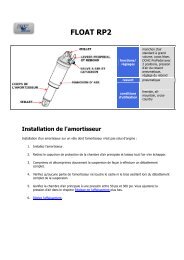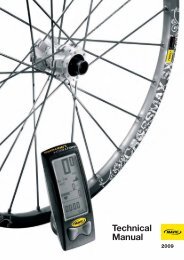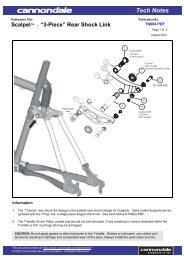Dlr2 & Sl Owner's Manual Supplement - lesrouleuxdewailly - Free
Dlr2 & Sl Owner's Manual Supplement - lesrouleuxdewailly - Free
Dlr2 & Sl Owner's Manual Supplement - lesrouleuxdewailly - Free
You also want an ePaper? Increase the reach of your titles
YUMPU automatically turns print PDFs into web optimized ePapers that Google loves.
suspension<br />
glossary<br />
Damping - The process of dissipating energy<br />
and slowing down the suspension motion.<br />
Damping absorbs the force of a bump or<br />
landing. Damping is usually done with oil,<br />
but can be done with air and friction as well.<br />
Spring - The part of a suspension fork or<br />
shock that holds the rider/bike up. Springs<br />
can be metal coils (steel or titanium) or high<br />
pressure air.<br />
Compression - The process of squeezing<br />
together. The front and rear suspension<br />
compress when hitting a bump, landing off<br />
a jump, or braking for corners. Compression<br />
can refer to the spring or damping<br />
(compression damping).<br />
Rebound - The process of extending back<br />
from a compressed state. The front and rear<br />
suspension rebound after being compressed<br />
from a bump or jump landing. Rebound can<br />
refer to the spring or damping (rebound<br />
damping).<br />
Low Speed (compression or rebound) - Low<br />
speed damping references the speed at<br />
which the fork/damper travels through its<br />
stroke. It does NOT refer to the speed at which<br />
the rider is moving. Low speed bumps are<br />
typically round in shape or smooth actions<br />
like jump landings and pedal bob. In the<br />
case of rebound, it mostly refers to rebound<br />
speed caused by smaller bumps where the<br />
fork does not get fully compressed.<br />
High Speed (compression or rebound) -<br />
High speed damping references the speed<br />
at which the fork/damper travels through<br />
its stroke. It does NOT refer to the speed at<br />
which the rider is moving. High speed bumps<br />
are typically square in shape or harsh terrain<br />
like sharp-edged rocks that may cause pinch<br />
flats. In the case of rebound, it mostly refers<br />
to rebound speed caused by larger bumps<br />
where the fork gets fully compressed.<br />
24<br />
Bottom Out - When the front or rear<br />
suspension fully compresses to absorb a<br />
bump or jump landing. A hard stop is usually<br />
felt at bottom out.<br />
Top Out - When the front or rear suspension<br />
fully extends after absorbing a bump or jump<br />
landing. A soft stop is usually felt at top out.<br />
The fork and shock are typically topped out<br />
without a rider on the bike.<br />
Compression Adjuster - Used to adjust the<br />
front or rear compression damping setting.<br />
Rebound Adjuster - Used to adjust the front<br />
and rear rebound setting<br />
Sag - Refers to how much the front and rear<br />
suspension compress when a rider sits on<br />
the bike. Sag is measured as a percentage<br />
of suspension travel. Typical sag values are:<br />
20-30% for XC riding and 25-35% for Trail/<br />
<strong>Free</strong>ride.<br />
Preload - Refers to how much initial<br />
compression is applied to a spring. In the<br />
case of an air spring, preload is achieved by<br />
increasing the air pressure. You use preload<br />
to adjust the sag. More preload decreases<br />
the sag. Less preload increases the sag.<br />
Spring Rate - Refers to the strength of a<br />
spring. A spring with a higher rate is stiffer, a<br />
lower rate softer.<br />
Diving - When a suspension fork compresses<br />
and causes the pitch of the bicycle drop.<br />
Mostly occurs when braking.<br />
Revalve - Revalving is the process of changing<br />
the internal compression and rebound shims<br />
to change the flow of oil through passages in<br />
the forks and shock. A suspension specialist<br />
should revalve your bike’s suspension.








